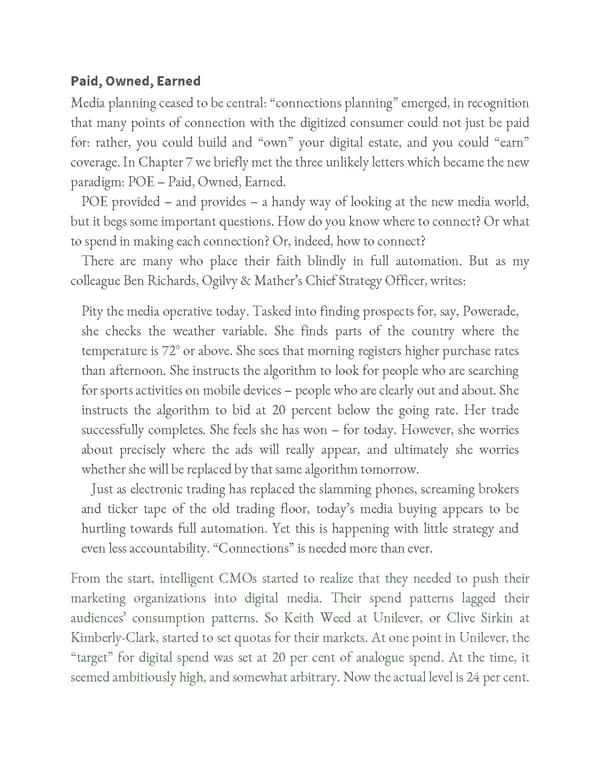Paid, Owned, Earned Media planning ceased to be central: “connections planning” emerged, in recognition that many points of connection with the digitized consumer could not just be paid for: rather, you could build and “own” your digital estate, and you could “earn” coverage. In Chapter 7 we briefly met the three unlikely letters which became the new paradigm: POE – Paid, Owned, Earned. POE provided – and provides – a handy way of looking at the new media world, but it begs some important questions. How do you know where to connect? Or what to spend in making each connection? Or, indeed, how to connect? There are many who place their faith blindly in full automation. But as my colleague Ben Richards, Ogilvy & Mather’s Chief Strategy Officer, writes: Pity the media operative today. Tasked into finding prospects for, say, Powerade, she checks the weather variable. She finds parts of the country where the temperature is 72° or above. She sees that morning registers higher purchase rates than afternoon. She instructs the algorithm to look for people who are searching for sports activities on mobile devices – people who are clearly out and about. She instructs the algorithm to bid at 20 percent below the going rate. Her trade successfully completes. She feels she has won – for today. However, she worries about precisely where the ads will really appear, and ultimately she worries whether she will be replaced by that same algorithm tomorrow. Just as electronic trading has replaced the slamming phones, screaming brokers and ticker tape of the old trading floor, today’s media buying appears to be hurtling towards full automation. Yet this is happening with little strategy and even less accountability. “Connections” is needed more than ever. From the start, intelligent CMOs started to realize that they needed to push their marketing organizations into digital media. Their spend patterns lagged their audiences’ consumption patterns. So Keith Weed at Unilever, or Clive Sirkin at Kimberly-Clark, started to set quotas for their markets. At one point in Unilever, the “target” for digital spend was set at 20 per cent of analogue spend. At the time, it seemed ambitiously high, and somewhat arbitrary. Now the actual level is 24 per cent.
 Ogilvy on Advertising in the Digital Age Page 234 Page 236
Ogilvy on Advertising in the Digital Age Page 234 Page 236